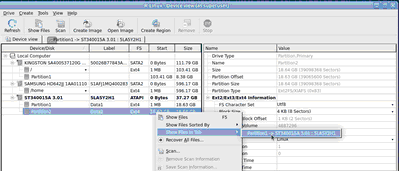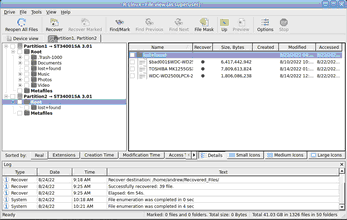


- Contents
- Index
- A -
- B -
Bad Sectors settings
Broken File Name
Rename and change all invalid symbols to:
Broken File Name options
Button
Buttons
- C -
Contact information and technical support
Context menu
Delete All Scanned Information
Find Previous Versions of the File
Find Template Signature Previous
Create menu
- D -
Data Copy in Text/hexadecimal viewer
Dialog boxes
Drive menu
- E -
Edit menu
Find Template Signature Previous
Exclusive Region options
- F -
File Already Exists
File mask options
File menu
File Systems settings
Default encoding for Ext2/Ext3/Ext4 volumes
File Types
Find options
Finding Previous File Versions
- H -
Help menu
- I -
Image options
Compressed image (R-Drive Image compatible)
- K -
Known File Types
- L -
Log settings
Maximum messages in the Event Log
- M -
Main settings
Messages
Double-click a logical disk...
- O -
Opening several disks/partitions in one tab
- P -
Panels
Panes
Properties tab
- R -
Recover options
Condense successful restoration events
Do not recover duplicate files from Extra Found Files
Open local folder (folders) when done
Recover alternative data streams
Recover real folders structure
Region options
- S -
Scan options
Search options
Settings
- T -
Tabs
Technical Information and Troubleshooting
Tools menu
- V -
Various Disk and Volume Managers
View menu
Opening several partitions in one tab
You may open several partitions in one tab. Then you may search for files and recover them from several disks/partitions at once. This is especially useful if files are to be recovered from several recognized partitions found on one real partition or a drive.
To open several partitions in one tab,
| 1 | Open one partition in a usual way ( double-click a logical disk, for example). |
| 2 | Right-click the next partition, select Show Files In Tab , and select the tab you want the partition appear in, or |
drag the disk/partition from the Device view to the required tab.
| > | R‑Studio for Linux will show files from several partitions in one tab |
Now files may be searched for, marked for recovery, and recovered.
To remove a partition from the tab,
| 1 | Right-click the required partition in the tab and select Close drive in the context menu. |
- R-Studio Technician: activation using a USB stick
- Data Recovery Guide
- Why R-Studio?
- R-Studio for Forensic and Data Recovery Business
- R-STUDIO Review on TopTenReviews
- File Recovery Specifics for SSD devices
- How to recover data from NVMe devices
- Predicting Success of Common Data Recovery Cases
- Recovery of Overwritten Data
- Emergency File Recovery Using R-Studio Emergency
- RAID Recovery Presentation
- R-Studio: Data recovery from a non-functional computer
- File Recovery from a Computer that Won't Boot
- Clone Disks Before File Recovery
- HD Video Recovery from SD cards
- File Recovery from an Unbootable Mac Computer
- The best way to recover files from a Mac system disk
- Data Recovery from an Encrypted Linux Disk after a System Crash
- Data Recovery from Apple Disk Images (.DMG files)
- File Recovery after Re-installing Windows
- R-Studio: Data Recovery over Network
- How To Use R-Studio Corporate Package
- Data Recovery from a Re-Formatted NTFS Disk
- Data Recovery from an ReFS disk
- Data Recovery from a Re-Formatted exFAT/FAT Disk
- Data Recovery from an Erased HFS Disk
- Data Recovery from an Erased APFS Disk
- Data Recovery from a Re-Formatted Ext2/3/4FS Disk
- Data Recovery from an XFS Disk
- Data Recovery from a Simple NAS
- How to connect virtual RAID and LVM/LDM volumes to the operating system
- Specifics of File Recovery After a Quick Format
- Data Recovery After Partition Manager Crash
- File Recovery vs. File Repair
- Data Recovery from Virtual Machines
- How to Recover Files from a Remote Computer Using R-Studio Standalone License and Its Network Capabilities in Demo Mode
- How to Connect Disks to a Computer
- Emergency Data Recovery over Network
- Data Recovery over the Internet
- Creating a Custom Known File Type for R-Studio
- Finding RAID parameters
- Recovering Partitions on a Damaged Disk
- NAT and Firewall Traversal for Remote Data Recovery
- Data Recovery from an External Disk with a Damaged File System
- File Recovery Basics
- Default Parameters of Software Stripe Sets (RAID 0) in Mac OS X
- Data Recovery from Virtual Hard Disk (VHD/VHDX) Files
- Data Recovery from Various File Container Formats and Encrypted Disks
- Automatic RAID Parameter Detection
- IntelligentScan Data Recovery Technology
- Multi-pass imaging in R-Studio
- Runtime Imaging in R-Studio
- Linear Imaging vs Runtime Imaging vs Multi-Pass Imaging
- USB Stabilizer Tech for unstable USB devices
- Joint work of R-Studio and PC-3000 UDMA hardware
- Joint work of R-Studio and HDDSuperClone
- R-Studio T80+ - A Professional Data Recovery and Forensic Solution for Small Business and Individuals Just for 1 USD/day
- Backup Articles
- R-Drive Image Standalone and Corporate license transferring
- Fixing Windows update error 0x80070643 with R-Drive Image
- Backup with Confidence
- R-Drive Image as a free powerful partition manager
- Computer Recovery and System Restore
- Disk Cloning and Mass System Deployment
- Accessing Individual Files or Folders on a Backed Up Disk Image
- R-Drive Image startup / bootable version
- File Backup for Personal Computers and Laptops of Home and Self-Employed Users
- Creating a Data Consistent, Space Efficient Data Backup Plan for a Small Business Server
- How to Move the Already Installed Windows from an Old HDD to a New SSD Device and Create a Hybrid Data Storage System
- How to Move an Installed Windows to a Larger Disk
- How to Move a BitLocker-Encrypted System Disk to a New Storage Device
- How to backup and restore disks on Linux and Mac computers using R-Drive Image
- Undelete Articles
- Get Deleted Files Back
- Free Recovery from SD and Memory cards
- R-Undelete: Video Recovery
- Recovery from an External Device with a Damaged File System
- File recovery from a non-functional computer
- Free File Recovery from an Android Phone Memory Card
- Free Photo and Video File Recovery Tutorial
- Easy file recovery in three steps




